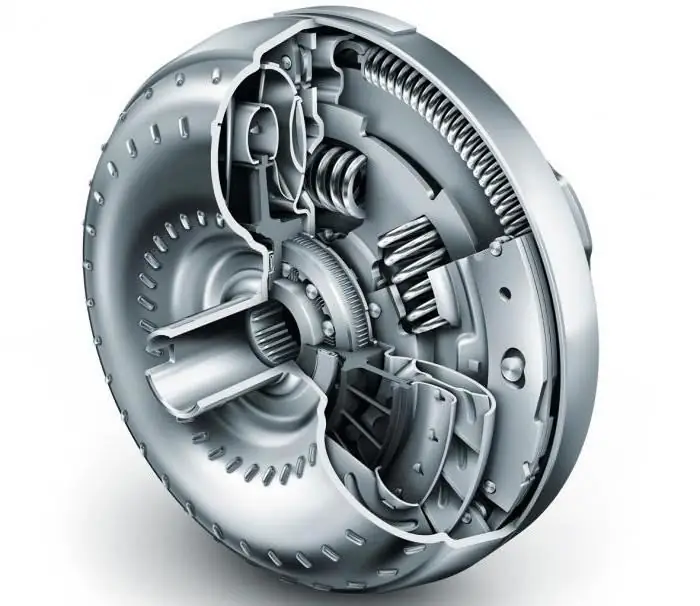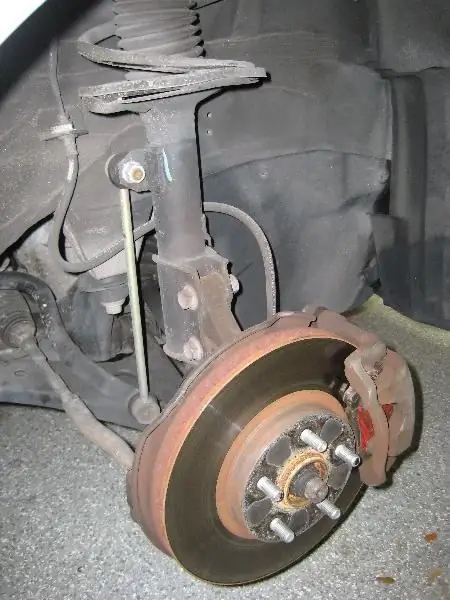2025 Author: Erin Ralphs | [email protected]. Last modified: 2025-01-22 21:14:11
From the article you will learn about what an internal CV joint (left and right) is on cars. Any machine is a complex mechanism that consists of many components. And all of them directly or indirectly affect the technical condition of the car, the comfortable stay in it, safe driving. On all machines with front-wheel drive (or all-wheel drive), there is such a part as a CV joint - a constant velocity joint. On different cars, it can have individual sizes, shapes, design features. But the general principle of operation for all constant velocity joints is the same, regardless of whether it is installed on a used VAZ car or on a new German, American, Japanese production.
What is the hinge for

These elements are installed on cars in which torque is transmitted to the front wheels. Inner CV joint left and right are the same. When buying new hinges, you need to pay attention only toCompatible with your car manufacturer's products. As you understand, the quality of the product also depends on the price - the more expensive the hinge, the better it is. The constant velocity joint ensures a secure connection between the differential in the gearbox and the front wheel hubs.
Note that the wheel hubs are well below the gearbox. Therefore, a simple shaft will not be able to dock them. The cardan shaft will also turn out to be ineffective - the loads are large, it is impossible to turn the steering wheel in the right direction while driving. The ideal solution is a CV joint, which allows the wheel drives to work in normal mode. And at the same time to carry out steering.
Characteristic breakdowns

It is worth noting one feature - the inner left CV joint ("Logan" or VAZ you have, it does not matter) and the right one wear out three times slower than the outer one. This is due to the fact that it is affected by a much smaller load. As for breakdowns, they are the same for internal and external. The most common is the natural wear of the balls in the hinge. Gaps increase, ball bearings become egg-shaped, which leads to the appearance of extraneous sounds, crunches, knocks.
Another common failure is a destroyed CV joint boot. Although it is made of thick and durable rubber, the service life is not very long. The fact is that the whole mechanism works in the immediate vicinity of the road surface. Consequently, all the dirt, water, chemicals will definitely get on the rubber. She iswill begin to dry out, cracks will appear, which will lead to the ingress of aggressive substances - water, sand and others. The result is a very rapid wear of the balls in the mechanism, the CV joint knocks, makes terrible sounds.
Tools and fixtures

To carry out the work, you will need a standard set of tools - open-end wrenches, box wrenches, socket wrenches. Screwdrivers, jack, pliers - this is all that everyone should have in the garage. But you also need special tools. For example, pullers for steering tips. In the event that you change the ball joint in parallel, a puller is also needed for it. But if you only intend to replace the inner CV joint (left or right), then these tools are not required.
It is worth noting that another key is needed for repairs - for 30. It is with its help that you need to unscrew the nut on the hub. It is desirable that this wrench has a large lever, since the nut is tightened with a very large moment. You also need wheel chocks under the rear wheels to prevent the car from moving. The presence of reliable supports is also necessary. And most importantly, a strong grip.
Preparing for repairs
Before starting work, you need to prepare the entire set of spare parts:
- Directly SHRUS.
- SHRUS boot.
- Two clamps.
- Graphite-based lubricant.
- Hub nut.
Only after that you can begin to carry out repairs. First of all, drain the oil from the gearbox. It is advisable to merge everything, it will be easier. ByIn fact, it is enough to pour out 2/3 of the total volume. In this case, when removing the hinge, oil will not spill out of the holes. Place chocks under the rear wheels. Then, using a hammer and a suitable drift, unlock the nut, unscrew it, lift the repaired side and remove the wheel.
Dismantling drive

To remove the drive from the car, you will need to perform a few more simple steps:
- Remove the cotter pin from the tie rod end by straightening it with pliers.
- Unscrew the nut with a 19 key. If it doesn't budge, treat it with a penetrating lubricant and try again in a few minutes.
- Install the puller on the steering knuckle, turn the main bolt clockwise. Tap with a hammer if necessary. After a few turns, the finger should come out of the fist.
- Remove the two bolts securing the ball joint to the front wheel hub.
- That's all practically, it remains only to knock out the front left CV joint (inner) with light taps, and only after it - the outer one.
Removing and installing CV joints on the drive

Now it's time to remove the hinges from the actuator. To do this, you can use two methods - the simplest and somewhat more complicated. The difference is whether a vice is used or not, and whether you plan to use the hinges for their intended purpose in the future. If "no" is the answer to all the questions posed above, then you can take it in one handthe entire drive, and in the other - a heavy hammer, apply sharp and strong blows until the hinge flies off. Thus, both the outer and inner CV joints are removed.
In order not to hold the drive in your hand, you can use a vise. Installation should be done carefully - everything is new, you should not spoil it. After all, you can easily damage the thread, and this will affect your own safety. Therefore, when stuffing the hinge onto the axle shaft, be sure to use wooden spacers. They allow you to eliminate the likelihood that the thread will be damaged. Please note that you must first install the anthers on the axle shaft, and only after that put the CV joints.
Drive assembly

Now the crucial moment has come - the installation of the assembled drive on the car. There is nothing difficult in this, it is enough to repeat all the disassembly steps in reverse order. In general terms, it will look like this:
- Insert the inner CV joint (VAZ or other car, it doesn't matter) into the gearbox. Moreover, it must enter so that the retaining ring inside opens and fixes the drive. Also pay attention to match the splines.
- Now you need to pull the hub together with the rack outward in order to install an external grenade into it.
- Fix the outer CV joint with a nut.
- Use two bolts to attach the ball joint housing to the wheel hub.
- Reinstall the tie rod end and tighten the nut. Fix it with a cotter pin.
- Install the wheel and lower the sidecar to the ground.
- Tighten the hub nut with a 30 wrench. Use a hammer and chisel to fix it on the thread.
Conclusion

In conclusion, it would be worth talking about the effectiveness of the repair. The fact is that you can install new CV joints. And you can buy the entire drive assembly. The question is which is better. Of course, the first option is cheaper. You can easily replace only the inner left CV joint (the price of the kit will be approximately 1000-1500 rubles, depending on the manufacturer). And in this case, it is quite acceptable not to touch the external grenade. But if you buy the entire drive assembly, then it will cost you at least 4,000 rubles. Accordingly, two drives is already a minimum of 8000. But the reliability of the assembly, as a rule, will be much better than in the first case.
Also, do not forget that the splines on the drive shaft gradually wear out. The older your car, the more wear and tear. The best way out is to replace not only the hinges, but also the axle shafts. And it is more convenient to do this by buying a drive assembly. But it all depends on the car. If it is old and easier to cut into metal than to repair, then why spend so much money? Indeed, in the market, when selling a car, they will no longer pay for the internal CV joint (left and right).
Recommended:
Left hand drive: advantages and disadvantages. Right-hand and left-hand traffic

The left hand drive car is a classic arrangement. In many cases, it is more profitable than the opposite counterpart. Especially in countries with right-hand traffic
Automatic torque converter: photo, principle of operation, malfunctions, automatic transmission torque converter replacement

Recently, cars with automatic transmissions have become in great demand. And no matter how much motorists say that automatic transmission is an unreliable mechanism that is expensive to maintain, statistics say the opposite. Every year there are fewer cars with manual transmission. The convenience of the "machine" was appreciated by many drivers. As for expensive maintenance, the most important part in this box is the automatic transmission torque converter
Do-it-yourself ball joint replacement

Imagine the situation. You are driving into nature, along a country road. Here the car runs into a bump, after which further movement is not possible, since the ball joint has torn out. But luckily, there is a car shop nearby. So now it just needs to be changed
Restoration of the ball joint. Repair, restoration, replacement of ball bearings

The main enemies of the ball joint have always been water and dirt. They can get on the joints only if the anther is worn. Replacing a worn ball joint (considering that it is non-separable) is a rather expensive pleasure, but restoring it, and even on your own, is quite possible and not so expensive
External grenade (SHRUS): device, possible malfunctions, repair and replacement

On front-wheel drive vehicles, there is such a part in the drive as a CV joint - this is a constant velocity joint. It provides transmission of torque from the transmission to the drive wheels. Motorists call this part "grenade". There are two CV joints in the car - external and internal. Let's talk about the outdoor grenade

